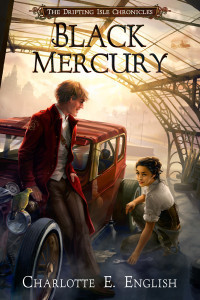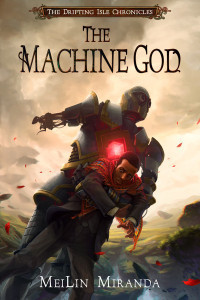Tips for Shared Worlds and Collaboration Between Independent Authors
Now that many of you have read Forged in Blood I (and tweeted/emailed/Facebooked glowers at me for that cliffhanger), I better let you know that I’m working hard to get Part 2 done this summer. I’m already a good 2/3rds of the way through the first draft and won’t be blogging much until I’ve finished it. But, for those authors who like to follow along and read new posts here, I will have a couple of guest articles coming up.
Today we have Charlotte E. English bringing us information on shared worlds and collaborating with other self-published authors. I grew up reading all those DragonLance and Forgotten Realms books, so I’m particularly intrigued by what they’ve put together. I hope you’ll find the post interesting as well and check out the books in the collaborative world they’ve created.
Sharing a World: When Indies Collaborate
 One of the best things about digital self-publishing, in my opinion, is the flexibility it offers: there’s so much freedom to write, and subsequently publish, anything our imaginations can come up with. There is also the freedom to find new and unusual ways to produce, and present, fiction.
One of the best things about digital self-publishing, in my opinion, is the flexibility it offers: there’s so much freedom to write, and subsequently publish, anything our imaginations can come up with. There is also the freedom to find new and unusual ways to produce, and present, fiction.
There are downsides, of course. One of the objections I hear the most to self-publishing is its isolated nature: there’s no one but you to get your book written, produced and published; no one to help you promote your book, or find its target market. But we’re making the rules, here. What’s to stop authors from forming collectives? Why not take the burden out of world-building by creating a team-built shared world? Why not work with a group of writers, to produce a series that never has to end? Why not create a group who’ll pool their efforts, share connections and help each other out?
Okay, maybe it’s a slightly crazy idea: in the early days, some people said it could never work. But a few of us decided to try it anyway. In January 2012, five fantasy authors got together and started world-building; in April 2013, we published the first few titles.
Building the World
So how did we do it?
 It’s probably fair to say that collaboration of this kind doesn’t necessarily come easily to writers. Most of us are used to working alone. The prospect of pouring the ideas of five complete strangers into a pot and coming out with a coherent world was a daunting one at first. Fortunately we had good leadership from our project founder, Joseph Robert Lewis – and this is the first thing I’d say any collaborative group needs. Joe got the ball rolling by taking lists of random ideas from everyone in the group and then getting us to vote on genre, theme, background and significant features in our world. What we ended up with was a steampunk/high fantasy world, a mysterious island floating in our skies, and such diverse features as talking birds, Shadowy assassins, steam-powered cars and flying machines and magical artefacts.
It’s probably fair to say that collaboration of this kind doesn’t necessarily come easily to writers. Most of us are used to working alone. The prospect of pouring the ideas of five complete strangers into a pot and coming out with a coherent world was a daunting one at first. Fortunately we had good leadership from our project founder, Joseph Robert Lewis – and this is the first thing I’d say any collaborative group needs. Joe got the ball rolling by taking lists of random ideas from everyone in the group and then getting us to vote on genre, theme, background and significant features in our world. What we ended up with was a steampunk/high fantasy world, a mysterious island floating in our skies, and such diverse features as talking birds, Shadowy assassins, steam-powered cars and flying machines and magical artefacts.
After that, it took a lot of emails and a lot of posts on our wiki site to hammer out the details. Was this easy? No, certainly not. It took months, and a lot of negotiating. We all had to learn to be as flexible as we could; to say “yes” as much as possible, and rarely to say no; to be both generous with sharing our ideas, and not too personally attached to them.
Writing the Books
That was only the beginning, of course: the ultimate goal was to produce a series of separate, stand-alone adventures that would, nonetheless, link up into a coherent series. Tricky. What we did was to give ourselves a big question to answer: what happens when somebody manages to fly up to that drifting isle, for the very first time?
The first three titles all answer this question in different ways. Writing them was an interesting experience, which naturally had its downsides: more than once I had to regretfully put away an idea I liked for my book, because it conflicted with someone else’s. But the upsides were tremendous: I got to work with many ideas I wouldn’t necessarily have come up with myself, and the whole process has stretched all of us as writers, forcing us to think differently, be more creative. It’s telling that we’ve only just published the first few titles, and already there are flurries of emails going around as we swap thoughts, bounce ideas off each other and begin making our way towards the next collection of books.
Sharing the World
Managing all this shared material isn’t as hard as it may sound. For a start, there are no co-written stories; each one of us is responsible for creating our own, separate books and for publishing them, too. That means there is no royalty sharing, and we each retain full rights to our own work and our own characters.
stories; each one of us is responsible for creating our own, separate books and for publishing them, too. That means there is no royalty sharing, and we each retain full rights to our own work and our own characters.
Everything else in our world is the joint property of the group. This, too, isn’t as difficult to manage as one might think. By this time, I struggle to remember which parts of our world were my ideas, and which came from others; we’ve spent so much time merrily digging in our sandpit that it doesn’t feel individualistic anymore. New ideas are always run by the whole group, and difficulties are rare.
What’s Next?
The next step in our team adventure is to bring in new writers; people who will add to the world we’ve already built, and make use of our existing material. This will stretch us again – but, I think, in good ways. What we’ve achieved so far is only the beginning: now we want to build more on top, plug new pieces into our literary jigsaw and keep it growing.
If this is going to work, it means continuing to be as flexible as we can. One of the ways we’re doing this is genre: while the world is high fantasy/steampunk, there’s no reason why all the stories have to be classic fantasy or steampunk in nature, too. We’re hoping to see writers from many different genres getting involved: why not have a romance set against a steampunk backdrop, or a cozy mystery with fantasy elements? Someone could start a paranormal angle, or write pure comedy. The sky’s the limit, and the more writers get involved, the more stories we add, and the more promotional efforts we’re sharing across the group, the greater the benefits to all.
If you’ve read this far and think it sounds interesting, there’s more information to be found at our website: www.driftingislechronicles.com/. If you’re a writer and you think you might like to participate, take a look at the get involved page where you can download the full participation guide.
If you want to check out the books (and maybe see who you’d be working with), the existing titles are:
Black Mercury by Charlotte E. English
The Kaiser Affair by Joseph Robert Lewis
The Machine God by MeiLin Miranda
Forthcoming title: Starcaster by Kat Parrish.
In Summary…
Working with a group brings a lot of extra work with it, this is true: there are miles to travel to make sure that the world and the stories remain consistent across so many titles and so many authors. But the advantages are, potentially, huge. If you’re looking for new ways to challenge yourself, or you’d like to work with something different; if you want to move beyond your comfort zone and revitalize your ideas; if you want help with promoting your work, or just someone to help watch your back and keep you going; all of these can be found with a good group.
Lindsay Buroker
- Lindsay Buroker's profile
- 6192 followers




